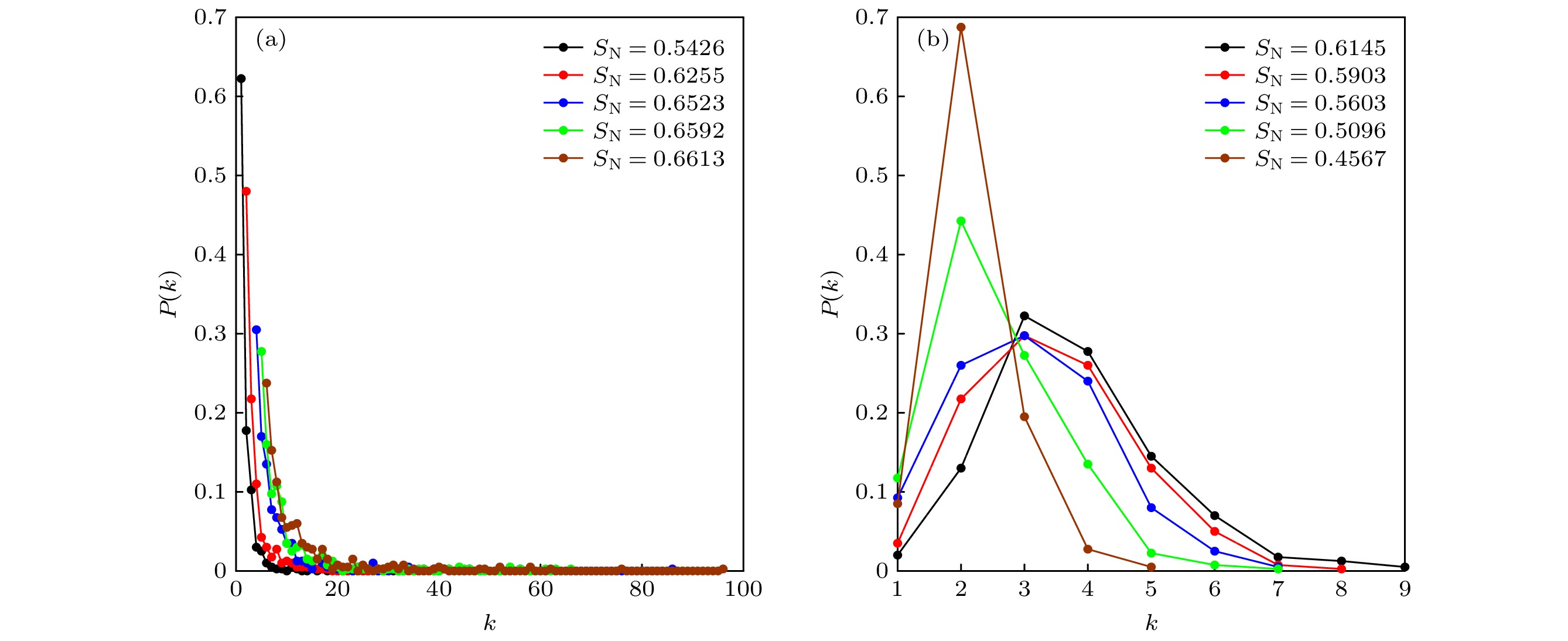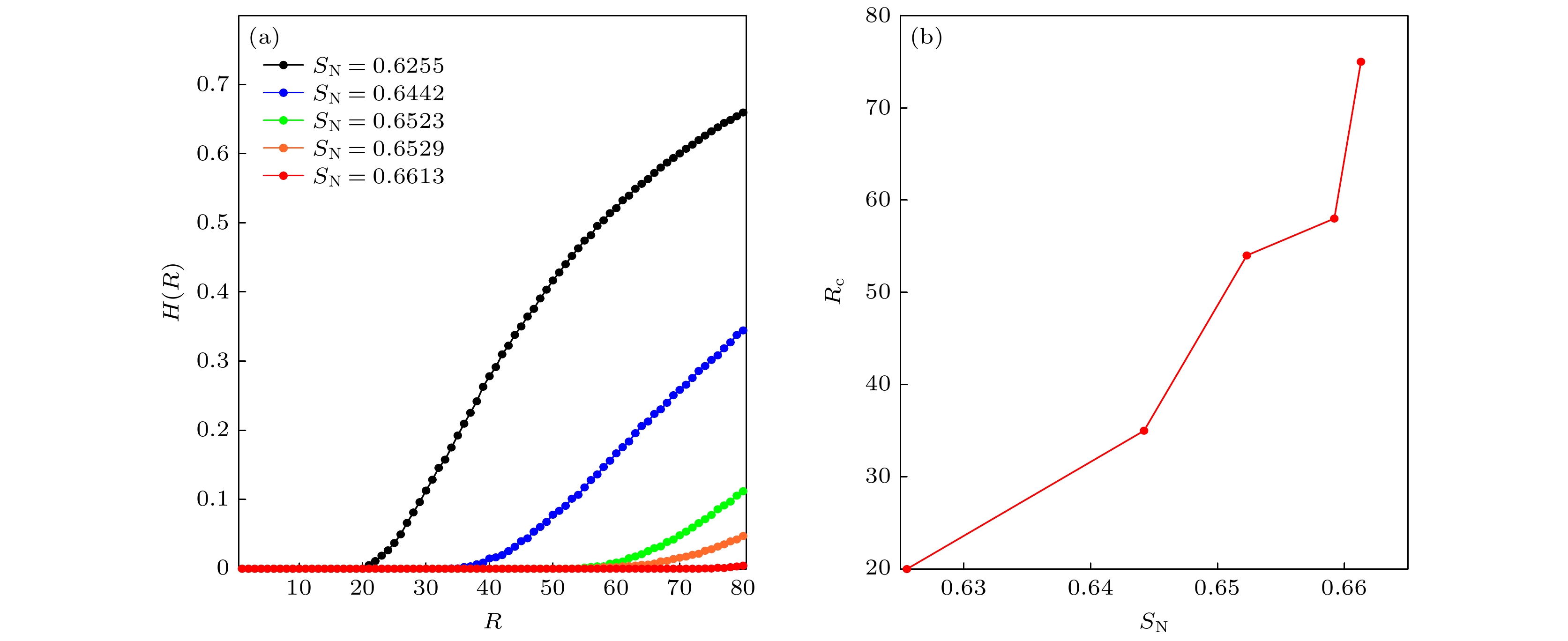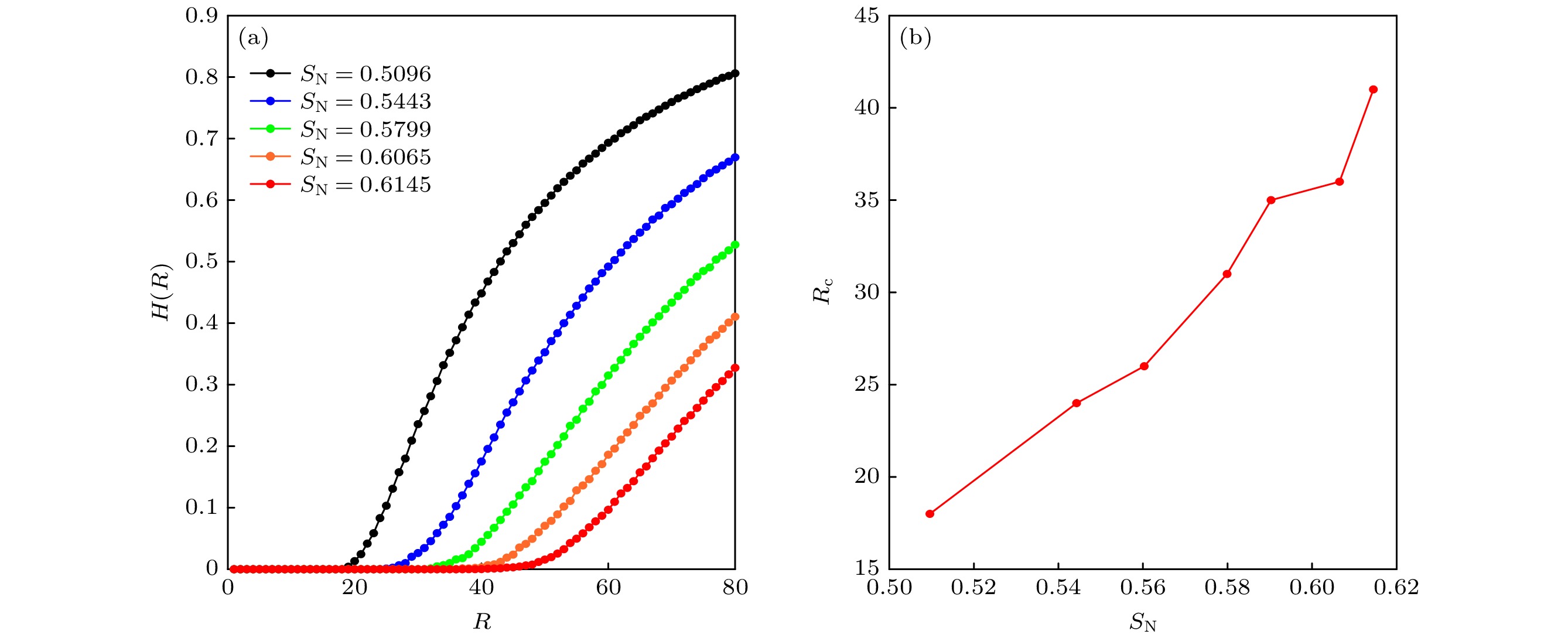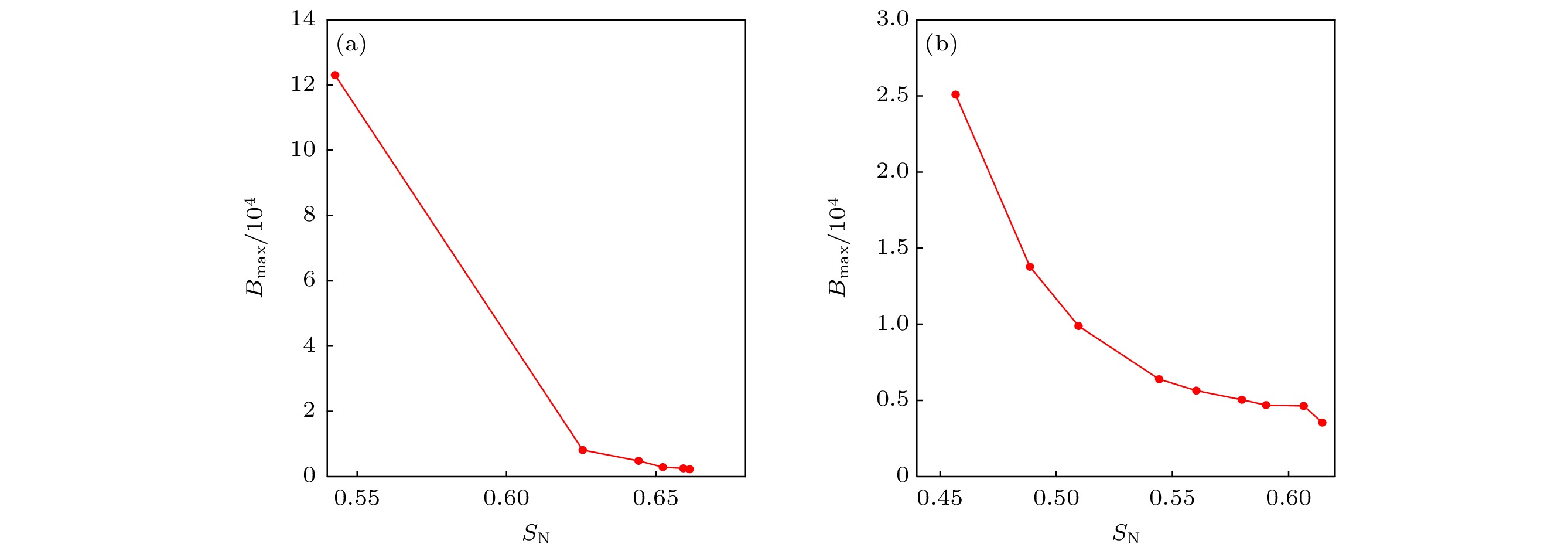-
网络的传输性能在一定程度上依赖于网络的拓扑结构. 本文从结构信息的角度分析复杂网络的传输动力学行为, 寻找影响网络传输容量的信息结构测度指标. 通信序列熵可以有效地量化网络的整体结构信息, 为了表征网络整体传输能力, 把通信序列熵引入到复杂网络传输动力学分析中, 研究网络的通信序列熵与传输性能之间的关联特性, 分析这种相关性存在的内在机理. 分别在BA无标度和WS小世界网络模型上进行仿真, 结果显示: 网络的通信序列熵与其传输容量存在密切关联性, 随着通信序列熵的增加, 网络拓扑结构的均匀性随之增强, 传输容量明显增加. 网络的传输容量是通信序列熵的单调递增函数, 与通信序列熵成正关联关系. 通信序列熵可有效评估网络的传输容量, 本结论可为设计高传输容量网络提供理论依据.The transmission performance of the network depends to a certain extent on the topology of the network. This article analyzes the traffic dynamics of complex networks from the perspective of structural information, and looks for information structure measurement indicators that affect network traffic capacity. Existing research shows that the communicability sequence entropy of complex networks can effectively quantify the overall structure of the network. Based on this measurement, the difference between networks can be effectively quantified, and the connotation of sequence entropy of communicability can be explained. Communication sequence entropy can effectively quantify the overall structure information of the network. In order to characterize the overall traffic capacity of the network, the communication sequence entropy is introduced into the phenomenon of complex network congestion, the correlation between the network communication sequence entropy and the transmission performance is studied, and the internal mechanism of this correlation is analyzed. Simulations in BA scale-free network model and WS small-world network model show that the communication sequence entropy of the network is closely related to its traffic capacity. As the communication sequence entropy increases, the uniformity of the network topology will increase, and the traffic capacity will increase significantly. The traffic capacity of the network is a monotonically increasing function of the entropy of the communication sequence, and is positively correlated with the entropy of the communication sequence. The communication sequence entropy of the network can effectively evaluate the traffic capacity of the network. This conclusion can provide a theoretical basis for the design of a high traffic capacity network and help provide an effective strategy for the design of the high traffic capacity of the network, which can be optimized by increasing the communication sequence entropy.
-
Keywords:
- complex network /
- communication sequence entropy /
- traffic capacity /
- congestion
[1] Wu G H, Yang H J, Pan J H 2018 Mod. Phys. Lett. B 9 1850137
 Google Scholar
Google Scholar
[2] Kumari S, Singh A 2019 Mod. Phys. Lett. B 1 13
 Google Scholar
Google Scholar
[3] Jiang L R, Jin X Y, Xia Y X, Ouyang B, Wu D P, Chen X 2014 Int. J. Distrib. Sens. Netw. 1155 764698
 Google Scholar
Google Scholar
[4] Tu H C, Xia Y X, Wu J J, Zhou X 2019 Physica A 9 17
[5] Bianchin G, Pasqualetti F 2020 IEEE Trans. Intell. Transp. 3013 3024
 Google Scholar
Google Scholar
[6] Serok N, Levy O, Havlin S, Blumenfeld-Lieberthal E 2019 EPB: Urban Analytics and City Science 1362 1376
 Google Scholar
Google Scholar
[7] Li H J, Wang H, Chen L N 2014 Europhys. Lett. 108 68009
 Google Scholar
Google Scholar
[8] Xiang J, Wang Z Z, Li H J, Zhang Y, Li F, Dong L P, Li J M, Guo L J 2017 J. Stat. Mech. Theory Exp. 5 053213
 Google Scholar
Google Scholar
[9] Chen G, Kong R, Wang Y X 2020 Physica A 540 123002
 Google Scholar
Google Scholar
[10] Barabási A L, Albert R 1999 Science 509 512
 Google Scholar
Google Scholar
[11] Watts D J, Strogatz S H 1998 Nature 440 442
[12] Tan F, Wu J J, Xia Y X, Tse C K 2014 Phys. Rev. E 89 062813
 Google Scholar
Google Scholar
[13] 杨卓璇, 马源培, 李慧嘉 2020 聊城大学学报 (自然科学版) 12 26
Yang Z X, Ma Y P, Li H J 2020 Journal of Liaocheng University (Social Science Edition) 12 26
[14] 马源培, 杨卓璇, 李慧嘉 2020 聊城大学学报(自然科学版) 26 32
Ma Y P, Yang Z X, Li H J 2020 Journal of Liaocheng University (Social Science Edition) 26 32
[15] Guimerà R, Díaz-Guilera A, Vega-Redondo F, Cabrales A, Arenas A 2002 Phys. Rev. Lett. 89 248701
 Google Scholar
Google Scholar
[16] Zhao L, Lai Y C, Park K, Ye N 2005 Phys. Rev. E 71 026125
 Google Scholar
Google Scholar
[17] 孙磊, 李荣, 靳聪, 陈孝国 2015 科技导报 86 89
 Google Scholar
Google Scholar
Sun L, Li R, Jin C, Chen X G 2015 Science and Technology Review 86 89
 Google Scholar
Google Scholar
[18] Chen Z H, Wu J J, Rong Z H, Tse C K 2018 Physica A 191 201
[19] Cai J, Wang Y, Liu Y, Luo J Z, Wei W G, Xu X P 2018 Future Gener. Comp. Syst. 765 771
 Google Scholar
Google Scholar
[20] 蔡君, 余顺争 2013 物理学报 62 058901
 Google Scholar
Google Scholar
Cai J, Yu S Z 2013 Acta Phys. Sin. 62 058901
 Google Scholar
Google Scholar
[21] Chen R B, Cui W, Pu C L, Li J, Ji B, Gakis K, Pardalos P M 2018 Physica A 524 532
 Google Scholar
Google Scholar
[22] Cui J B, Xiang J, Liu Y, Hu K, Tang Y 2020 J. Phys. Soc. Jpn. 89 014802
 Google Scholar
Google Scholar
[23] DuBois T, Eubank S, Srinivasan A 2012 Electron. J. Comb. 1 19
[24] Hu K, Liu C, Hu T, Tang Y 2010 J. Phys. A: Math. Theor. 43 175101
 Google Scholar
Google Scholar
[25] Huang W, Tommy W S C 2010 J. Stat. Mech. Theory Exp. 1 12
 Google Scholar
Google Scholar
[26] Jiang Z Y, Liang M G, Guo D C 2011 Int. J. Mod. Phys. C 1211 1226
 Google Scholar
Google Scholar
[27] Jiang Z Y, Liang M G, An W J 2014 Physica A 379 385
 Google Scholar
Google Scholar
[28] Jiang Z Y, Liang M G, Guo D C 2013 Mod. Phys. Lett. B 8 1350056
 Google Scholar
Google Scholar
[29] 陈乐瑞, 潘秋萍, 孔金生 2016 计算机系统应用 145 148
 Google Scholar
Google Scholar
Chen L R, Pan Q P, Kong J S 2016 Computer Systems and Applications 145 148
 Google Scholar
Google Scholar
[30] 孙中悦, 贾兴华 2017 计算机工程 75 78
 Google Scholar
Google Scholar
Sun Z Y, Jia X H 2017 Computer Engineering 75 78
 Google Scholar
Google Scholar
[31] Wang D, Liu E W, Liu D, Qu X Y, Ma R F, Wang P, Liu X C 2015 IEEE Commun. Lett. 2110 2113
 Google Scholar
Google Scholar
[32] Zhang G Q, Wang D, Li G J 2007 Phys. Rev. E 76 017101
 Google Scholar
Google Scholar
[33] Zhang S, Liang M G, Jiang Z Y, Wu J J 2014 Int. J. Mod. Phys. C 6 1450014
 Google Scholar
Google Scholar
[34] Zhang Z H, Liu S Y, Yang Y Q, Bai Y G 2019 Cluster Comput. 7687 7694
[35] 申弢, 黄树红, 韩守木, 杨叔子 2001 机械工程学报 94 98
Shen T, Huang S H, Han S M, Yang S Z 2001 Journal of Mechanical Engineering 94 98
[36] 赵荣珍, 张优云 2004 振动、测试与诊断 180 187
Zhao R Z, Zhang Y Y 2004 Journal of Vibration, Measurement and Diagnosis 180 187
[37] 王治忠, 钱龙龙, 韩闯, 师丽 2020 计算机应用 608 615
 Google Scholar
Google Scholar
Wang Z Z, Qian L L, Han C, Shi L 2020 Journal of Computer Applications 608 615
 Google Scholar
Google Scholar
[38] Wang B, Tang H W, Guo C H, Xiu Z L 2006 Physica A 363 591
 Google Scholar
Google Scholar
[39] 吴俊, 谭跃进, 邓宏钟, 朱大智 2007 系统工程理论与实践 101 105
Wu J, Tan Y J, Deng H Z, Zhu D Z 2007 Syst. Engin. Theo. Prac. 101 105
[40] 蔡萌, 杜海峰, 任义科, 费尔德曼 2011 物理学报 60 110513
 Google Scholar
Google Scholar
Cai M, Du H F, Ren Y K, Marcus W F 2011 Acta Phys. Sin. 60 110513
 Google Scholar
Google Scholar
[41] 蔡萌, 杜海峰, 费尔德曼 2014 物理学报 63 060504
 Google Scholar
Google Scholar
Cai M, Du H F, Marcus W F 2014 Acta Phys. Sin. 63 060504
 Google Scholar
Google Scholar
[42] 胡钢, 徐翔, 高浩, 过秀成 2020 系统工程理论与实践 714 725
 Google Scholar
Google Scholar
Hu G, Xu X, Gao H, Guo X C 2020 Syst. Engin. Theo. Prac. 714 725
 Google Scholar
Google Scholar
[43] Chen D, Shi D D, Qin M, Xu S M, Pan G J 2018 Phys. Rev. E 98 012319
 Google Scholar
Google Scholar
[44] 陈单, 石丹丹, 潘贵军 2019 物理学 报 68 118901
 Google Scholar
Google Scholar
Chen D, Shi D D, Pan G J 2019 Acta Phys. Sin. 68 118901
 Google Scholar
Google Scholar
[45] 石丹丹, 陈单, 龙慧敏, 王承科, 潘贵军 2019 中国科学:物理学力学天文学 49 070502
 Google Scholar
Google Scholar
Shi D D, Chen D, Long H M, Wang C K, Pan G J 2019 Science China Physics, Mechanics and Astronomy 49 070502
 Google Scholar
Google Scholar
[46] Estrada E, Hatano N 2008 Phys. Rev. E 77 036111
 Google Scholar
Google Scholar
[47] Estrada E 2012 Linear Algebra Appl. 4317 4328
 Google Scholar
Google Scholar
[48] Estrada E, Hatano N, Benzi M 2012 Phys. Rep. 89 119
 Google Scholar
Google Scholar
[49] Mukherjee G, Manna S S 2005 Phys. Rev. E 71 066108
 Google Scholar
Google Scholar
[50] Zhou T, Yan G, Wang B H, Fu Z Q, Hu B, Zhu C P, Wang W X 2006 Dyam. Cont. Dis. Ser. B 13 463
[51] Barthélemy M 2004 EurPhys. J. B 163 168
 Google Scholar
Google Scholar
[52] Holme P, Kim B J, Yoon C N, Han S K 2002 Phys. Rev. E 65 066109
 Google Scholar
Google Scholar
[53] Jiang Z Y, Liang M G 2012 Mod. Phys. Lett. B 29 1250195
 Google Scholar
Google Scholar
[54] Yan G, Zhou T, Hu B, Fu Z Q, Wang B H 2006 Phys. Rev. E 73 046108
 Google Scholar
Google Scholar
-
图 2 (a)不同的通信序列熵的BA无标度网络下, 有序参数H(R)与数据包生成率R的关系; (b) BA无标度网络通信序列熵
$S_{\rm N}$ 与传输容量$R_{\rm c}$ 的关系. 采用的路由策略为有效路由策略Fig. 2. (a) Relationship between the order parameter H(R) and the packet generation rate R under BA scale-free network with different communication sequence entropy; (b) relationship between BA scale-free network communication sequence entropy
$S_{\rm N}$ and traffic capacity$R_{\rm c}$ . The routing strategy adopted is an effective routing strategy.图 3 (a)不同的通信序列熵的WS小世界网络下, 有序参数H(R)与数据包生成率R的关系; (b) WS小世界网络通信序列熵
$S_{\rm N}$ 与传输容量$R_{\rm c}$ 的关系. 采用的路由策略为有效路由策略Fig. 3. (a) Relationship between the order parameters
$H(R)$ and the packet generation rate R under the WS small world network with different communication sequence entropy; (b) relationship between WS small world network communication sequence entropy$S_{\rm N}$ and traffic capacity$R_{\rm c}$ . The routing strategy adopted is an effective routing strategy. -
[1] Wu G H, Yang H J, Pan J H 2018 Mod. Phys. Lett. B 9 1850137
 Google Scholar
Google Scholar
[2] Kumari S, Singh A 2019 Mod. Phys. Lett. B 1 13
 Google Scholar
Google Scholar
[3] Jiang L R, Jin X Y, Xia Y X, Ouyang B, Wu D P, Chen X 2014 Int. J. Distrib. Sens. Netw. 1155 764698
 Google Scholar
Google Scholar
[4] Tu H C, Xia Y X, Wu J J, Zhou X 2019 Physica A 9 17
[5] Bianchin G, Pasqualetti F 2020 IEEE Trans. Intell. Transp. 3013 3024
 Google Scholar
Google Scholar
[6] Serok N, Levy O, Havlin S, Blumenfeld-Lieberthal E 2019 EPB: Urban Analytics and City Science 1362 1376
 Google Scholar
Google Scholar
[7] Li H J, Wang H, Chen L N 2014 Europhys. Lett. 108 68009
 Google Scholar
Google Scholar
[8] Xiang J, Wang Z Z, Li H J, Zhang Y, Li F, Dong L P, Li J M, Guo L J 2017 J. Stat. Mech. Theory Exp. 5 053213
 Google Scholar
Google Scholar
[9] Chen G, Kong R, Wang Y X 2020 Physica A 540 123002
 Google Scholar
Google Scholar
[10] Barabási A L, Albert R 1999 Science 509 512
 Google Scholar
Google Scholar
[11] Watts D J, Strogatz S H 1998 Nature 440 442
[12] Tan F, Wu J J, Xia Y X, Tse C K 2014 Phys. Rev. E 89 062813
 Google Scholar
Google Scholar
[13] 杨卓璇, 马源培, 李慧嘉 2020 聊城大学学报 (自然科学版) 12 26
Yang Z X, Ma Y P, Li H J 2020 Journal of Liaocheng University (Social Science Edition) 12 26
[14] 马源培, 杨卓璇, 李慧嘉 2020 聊城大学学报(自然科学版) 26 32
Ma Y P, Yang Z X, Li H J 2020 Journal of Liaocheng University (Social Science Edition) 26 32
[15] Guimerà R, Díaz-Guilera A, Vega-Redondo F, Cabrales A, Arenas A 2002 Phys. Rev. Lett. 89 248701
 Google Scholar
Google Scholar
[16] Zhao L, Lai Y C, Park K, Ye N 2005 Phys. Rev. E 71 026125
 Google Scholar
Google Scholar
[17] 孙磊, 李荣, 靳聪, 陈孝国 2015 科技导报 86 89
 Google Scholar
Google Scholar
Sun L, Li R, Jin C, Chen X G 2015 Science and Technology Review 86 89
 Google Scholar
Google Scholar
[18] Chen Z H, Wu J J, Rong Z H, Tse C K 2018 Physica A 191 201
[19] Cai J, Wang Y, Liu Y, Luo J Z, Wei W G, Xu X P 2018 Future Gener. Comp. Syst. 765 771
 Google Scholar
Google Scholar
[20] 蔡君, 余顺争 2013 物理学报 62 058901
 Google Scholar
Google Scholar
Cai J, Yu S Z 2013 Acta Phys. Sin. 62 058901
 Google Scholar
Google Scholar
[21] Chen R B, Cui W, Pu C L, Li J, Ji B, Gakis K, Pardalos P M 2018 Physica A 524 532
 Google Scholar
Google Scholar
[22] Cui J B, Xiang J, Liu Y, Hu K, Tang Y 2020 J. Phys. Soc. Jpn. 89 014802
 Google Scholar
Google Scholar
[23] DuBois T, Eubank S, Srinivasan A 2012 Electron. J. Comb. 1 19
[24] Hu K, Liu C, Hu T, Tang Y 2010 J. Phys. A: Math. Theor. 43 175101
 Google Scholar
Google Scholar
[25] Huang W, Tommy W S C 2010 J. Stat. Mech. Theory Exp. 1 12
 Google Scholar
Google Scholar
[26] Jiang Z Y, Liang M G, Guo D C 2011 Int. J. Mod. Phys. C 1211 1226
 Google Scholar
Google Scholar
[27] Jiang Z Y, Liang M G, An W J 2014 Physica A 379 385
 Google Scholar
Google Scholar
[28] Jiang Z Y, Liang M G, Guo D C 2013 Mod. Phys. Lett. B 8 1350056
 Google Scholar
Google Scholar
[29] 陈乐瑞, 潘秋萍, 孔金生 2016 计算机系统应用 145 148
 Google Scholar
Google Scholar
Chen L R, Pan Q P, Kong J S 2016 Computer Systems and Applications 145 148
 Google Scholar
Google Scholar
[30] 孙中悦, 贾兴华 2017 计算机工程 75 78
 Google Scholar
Google Scholar
Sun Z Y, Jia X H 2017 Computer Engineering 75 78
 Google Scholar
Google Scholar
[31] Wang D, Liu E W, Liu D, Qu X Y, Ma R F, Wang P, Liu X C 2015 IEEE Commun. Lett. 2110 2113
 Google Scholar
Google Scholar
[32] Zhang G Q, Wang D, Li G J 2007 Phys. Rev. E 76 017101
 Google Scholar
Google Scholar
[33] Zhang S, Liang M G, Jiang Z Y, Wu J J 2014 Int. J. Mod. Phys. C 6 1450014
 Google Scholar
Google Scholar
[34] Zhang Z H, Liu S Y, Yang Y Q, Bai Y G 2019 Cluster Comput. 7687 7694
[35] 申弢, 黄树红, 韩守木, 杨叔子 2001 机械工程学报 94 98
Shen T, Huang S H, Han S M, Yang S Z 2001 Journal of Mechanical Engineering 94 98
[36] 赵荣珍, 张优云 2004 振动、测试与诊断 180 187
Zhao R Z, Zhang Y Y 2004 Journal of Vibration, Measurement and Diagnosis 180 187
[37] 王治忠, 钱龙龙, 韩闯, 师丽 2020 计算机应用 608 615
 Google Scholar
Google Scholar
Wang Z Z, Qian L L, Han C, Shi L 2020 Journal of Computer Applications 608 615
 Google Scholar
Google Scholar
[38] Wang B, Tang H W, Guo C H, Xiu Z L 2006 Physica A 363 591
 Google Scholar
Google Scholar
[39] 吴俊, 谭跃进, 邓宏钟, 朱大智 2007 系统工程理论与实践 101 105
Wu J, Tan Y J, Deng H Z, Zhu D Z 2007 Syst. Engin. Theo. Prac. 101 105
[40] 蔡萌, 杜海峰, 任义科, 费尔德曼 2011 物理学报 60 110513
 Google Scholar
Google Scholar
Cai M, Du H F, Ren Y K, Marcus W F 2011 Acta Phys. Sin. 60 110513
 Google Scholar
Google Scholar
[41] 蔡萌, 杜海峰, 费尔德曼 2014 物理学报 63 060504
 Google Scholar
Google Scholar
Cai M, Du H F, Marcus W F 2014 Acta Phys. Sin. 63 060504
 Google Scholar
Google Scholar
[42] 胡钢, 徐翔, 高浩, 过秀成 2020 系统工程理论与实践 714 725
 Google Scholar
Google Scholar
Hu G, Xu X, Gao H, Guo X C 2020 Syst. Engin. Theo. Prac. 714 725
 Google Scholar
Google Scholar
[43] Chen D, Shi D D, Qin M, Xu S M, Pan G J 2018 Phys. Rev. E 98 012319
 Google Scholar
Google Scholar
[44] 陈单, 石丹丹, 潘贵军 2019 物理学 报 68 118901
 Google Scholar
Google Scholar
Chen D, Shi D D, Pan G J 2019 Acta Phys. Sin. 68 118901
 Google Scholar
Google Scholar
[45] 石丹丹, 陈单, 龙慧敏, 王承科, 潘贵军 2019 中国科学:物理学力学天文学 49 070502
 Google Scholar
Google Scholar
Shi D D, Chen D, Long H M, Wang C K, Pan G J 2019 Science China Physics, Mechanics and Astronomy 49 070502
 Google Scholar
Google Scholar
[46] Estrada E, Hatano N 2008 Phys. Rev. E 77 036111
 Google Scholar
Google Scholar
[47] Estrada E 2012 Linear Algebra Appl. 4317 4328
 Google Scholar
Google Scholar
[48] Estrada E, Hatano N, Benzi M 2012 Phys. Rep. 89 119
 Google Scholar
Google Scholar
[49] Mukherjee G, Manna S S 2005 Phys. Rev. E 71 066108
 Google Scholar
Google Scholar
[50] Zhou T, Yan G, Wang B H, Fu Z Q, Hu B, Zhu C P, Wang W X 2006 Dyam. Cont. Dis. Ser. B 13 463
[51] Barthélemy M 2004 EurPhys. J. B 163 168
 Google Scholar
Google Scholar
[52] Holme P, Kim B J, Yoon C N, Han S K 2002 Phys. Rev. E 65 066109
 Google Scholar
Google Scholar
[53] Jiang Z Y, Liang M G 2012 Mod. Phys. Lett. B 29 1250195
 Google Scholar
Google Scholar
[54] Yan G, Zhou T, Hu B, Fu Z Q, Wang B H 2006 Phys. Rev. E 73 046108
 Google Scholar
Google Scholar
计量
- 文章访问数: 8468
- PDF下载量: 161
- 被引次数: 0














 下载:
下载:





















